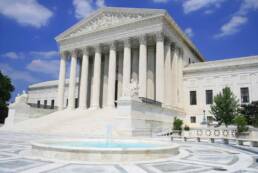Background
On his first day back in office, President Trump issued Executive Order (EO) No. 14160. This EO identifies circumstances in which a person born in the U.S. is not “subject to the jurisdiction thereof” and therefore is notrecognized as an American citizen.
Multiple individuals, groups, and States filed lawsuits in federal courts seeking an injunction against the President’s EO. All district court federal judges granted plaintiffs’ motions for injunction, therefore putting a hold on the EO. In each case, the Trump Administration appealed to the Court of Appeals and lost all appeals.
When issuing the injunctions, the district court judges issued “universal injunctions” which bar the executive officials from applying the EO to anyone, not just the plaintiffs themselves. The Trump Administration, therefore, contends that this is an unconstitutional use of judicial power of the district courts since they do not have jurisdiction over “anyone”.
Although the district court cases discuss the issue of the constitutionality of the President’s EO, this emergency application does not discuss or address that specific issue.
Trump v. CASA Inc.
The Trump Administration filed an emergency application with SCOTUS for partial stay, contending that universal injunctions used by district courts are unconstitutional. Respondents are individuals, organizations, and States that filed three separate lawsuits to enjoin the implementation and enforcement of the EO.
The issue raised is whether Congress has granted federal courts the authority to universally enjoin the enforcement of an executive order?
Trump Administration Argument
The Trump Administration argues that district courts do not have the authority to issue universal injunctions. They argue that a universal injunction can only be justified as an exercise of equitable authority based on the Judiciary Act of 1789, which gives federal courts jurisdiction over “all suits….in equity”. SCOTUS has previously held that the statutory grant encompasses only those sorts of equitable remedies “traditionally accorded by courts of equity” at our country’s inception.
Respondents’ Argument
Respondents argue that universal injunctions are the modern day equivalent of the decree resulting from the “bill of peace”, a form of group litigation in the Courts of England. Respondents argue that the existence of this historic equitable device means that federal courts have the equitable authority to issue universal injunctions under the Judiciary Act.
SCOTUS Holding
SCOTUS held that universal injunctions are not analogous to any relief available in the court of equity in England at the time of the founding. Group Mexicano, 527 U.S., at 318-319. The Court emphasized that because the universal injunction lacks historical pedigree, it falls outside the bounds of a federal court’s equitable authority under the Judiciary Act.
The Court rejected the Respondents’ argument that the “bill of peace” is the modern-day equivalent of universal injunctions. The Court held the bill of peace does live in modern form, but instead it is analogous to the modern class action governed by Rule 23 of the Fed. Rules of Civ. Pro. Unlike universal injunctions, which reach anyone affected by the executive or legislative action, the bill of peace involved “a group that was small and cohesive,” which is much more analogous to Rule 23 class actions.
The Court held that in order for the Government to obtain interim relief, it must show that it is likely to “suffer irreparable harm absent a stay” Nken, 556 U.S., at 434-435. In this case, the Government has met that burden by showing that when a federal court enters a universal injunction against the Government, it “improperly intrudes” on “a coordinate branch of the government” and prevents the Government from enforcing its policies against non-parties. The Court held that a partial stay will cause no harm to the Respondents because they will remain protected by the preliminary injunctions to the extent necessary and appropriate to afford them complete relief.
Conclusion
This means that any challenge to birthright citizenship lawsuit must now make its way entirely through the federal court system before a decision is made. Until then, potential plaintiffs have only preliminary protections of their interests against the EO. As of today, June 27, 2025, the SCOTUS term has ended and will not resume until Fall; therefore, the soonest a case will be heard regarding the issue of whether the EO is constitutional will be this Fall 2025.
This also means that universal injunctions on other issues/EOs/legislative actions are no longer allowed by district court judges.
At Berardi Immigration Law, we stay on the forefront of legal and policy changes that impact your immigration journey. Whether you’re navigating complex citizenship questions or seeking clarity on how executive orders may affect your case, our team is here to guide you every step of the way. If you have questions or concerns about your status or eligibility, contact us today to schedule a consultation.
Ready to have Berardi on your side?
Whether you’re a business looking to hire or a professional hoping to relocate, immigration law can be complicated. But you don’t have to do it alone. Put our experience to work for you.



